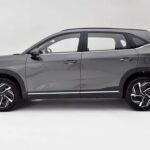Despite the industry’s increasing focus on electric vehicles, Toyota, Subaru, and Mazda remain committed to developing innovative internal combustion engine (ICE) technologies for their future models. The new engines have been specifically designed and tailor-made for electrification, featuring integrated EV components.
Despite industry trends shifting towards electric vehicles, Toyota, Subaru, and Mazda are doubling down on internal combustion engine (ICE) technology. The Japanese automakers are committing to a significant investment in traditional gasoline-powered cars, signaling a cautious approach to the shift towards electrification.
Japanese automakers have been among the most sluggish in embracing a complete shift towards electric vehicles. Due to this, Toyota again topped the list of the worst-ranked automakers on InfluenceMap’s annual report on climate change lobbying.
The rankings primarily consider automakers’ electric vehicle strategies and their efforts to influence climate-friendly government policies in an adverse manner.
Tesla, Ford, General Motors, Volkswagen, and Mercedes-Benz led the pack, while Toyota, Mazda, and Suzuki trailed behind.
Toyota, Mazda, and Subaru are bucking the trend by continuing to invest in internal combustion engine (ICE) technology. At a high-profile press event on Tuesday, the companies formally committed themselves to developing innovative engines specifically designed for electrification and the quest towards carbon neutrality.
Automakers aim to integrate electric vehicle (EV) components, including motors, batteries, and diverse electrical drive systems, into innovative engine designs.
As new generation electric vehicles (EVs) from Toyota take shape, industry insiders anticipate the introduction of smaller, more compact models tailored to fit the automaker’s revised design language. Compact engines enable reduced hoodlines and enhanced aerodynamics, yielding increased efficiency and fuel effectiveness.
The participating businesses have reiterated their commitment to adopting a comprehensive, multi-faceted approach towards achieving carbon neutrality.
“To cater to customers seeking carbon neutrality, it is crucial to adapt engine technology to align with the future’s energy landscape,” Toyota CEO Koji Sato said.

Sato clarified that the three companies would foster advancements in engine technologies through healthy competitions.
The company’s strategy hinges on a trifecta of innovative fuels: e-fuel, biofuels, and liquid hydrogen. Toyota asserts that its innovative internal combustion engine (ICE) technology will help accelerate the widespread use of alternative clean energy sources.
Businesses announced that brand-new engines are in development and will likely be released at some point, but did not provide a specific timeline for their market debut.
Electrek’s Take
While the global automotive industry is pivoting towards an all-electric future, Toyota and its Japanese peers are determined to keep the internal combustion engine in the game?
As Toyota’s US chief, Ted Ogawa asserts that the corporation is finally gaining ground on electric vehicles (EVs) and innovative technology, indicating a sense of momentum in their efforts to stay competitive. Amongst the more than 2.2 million vehicles Toyota purchased in the US last year, a mere 9,329 were fully electric, equating to less than 0.5% of the total.
While several automakers have achieved significant electric vehicle (EV) market share, Toyota and its peers continue to allocate resources towards internal combustion engine (ICE) development.
The global impact of this development will be substantial. By the end of March, Toyota and its luxury brand Lexus had sold a cumulative total of 30,109 all-electric vehicles worldwide. While that’s a small fraction, it still accounts for…
By 2026 at the earliest, Toyota plans to roll out its next-generation electric vehicle batteries, a development that’s been anticipated for some time now.
As the market shifts towards electric vehicles, investing solely in internal combustion engine (ICE) technologies may lead Toyota, Subaru, and Mazda to further fall behind the competition.
What does it say about Toyota’s commitment to sustainability that they’re still pouring resources into internal combustion engine (ICE) development? What sparks the creative process in individuals?











